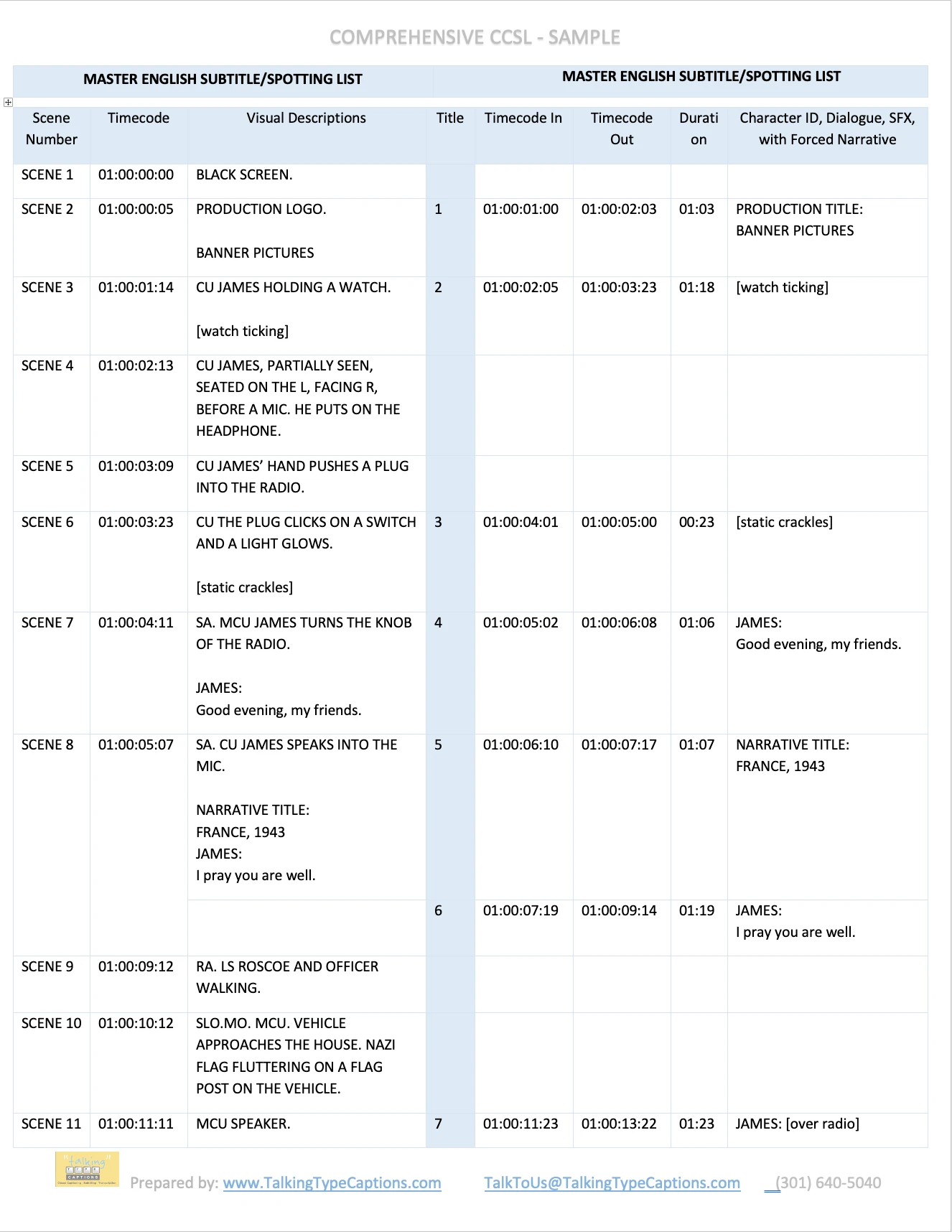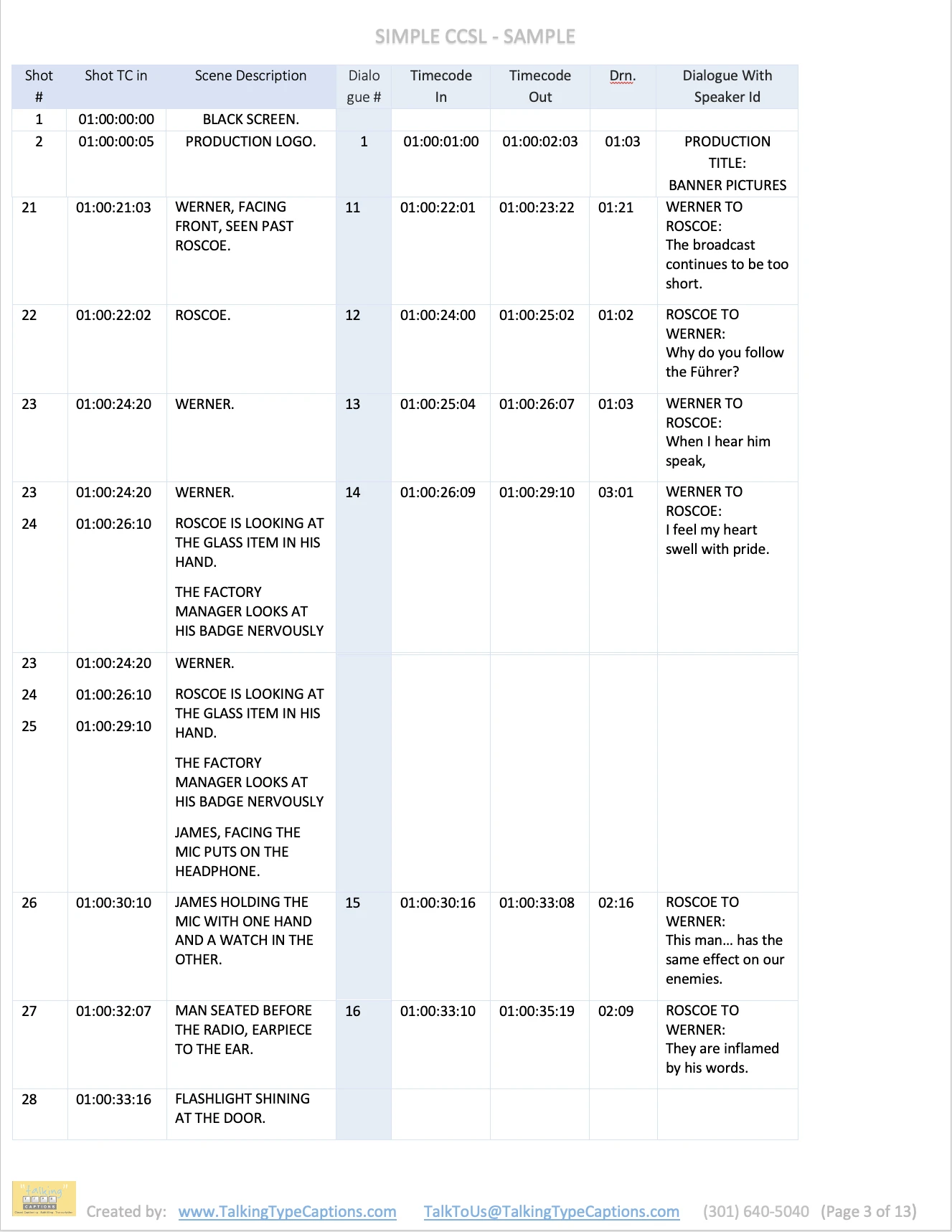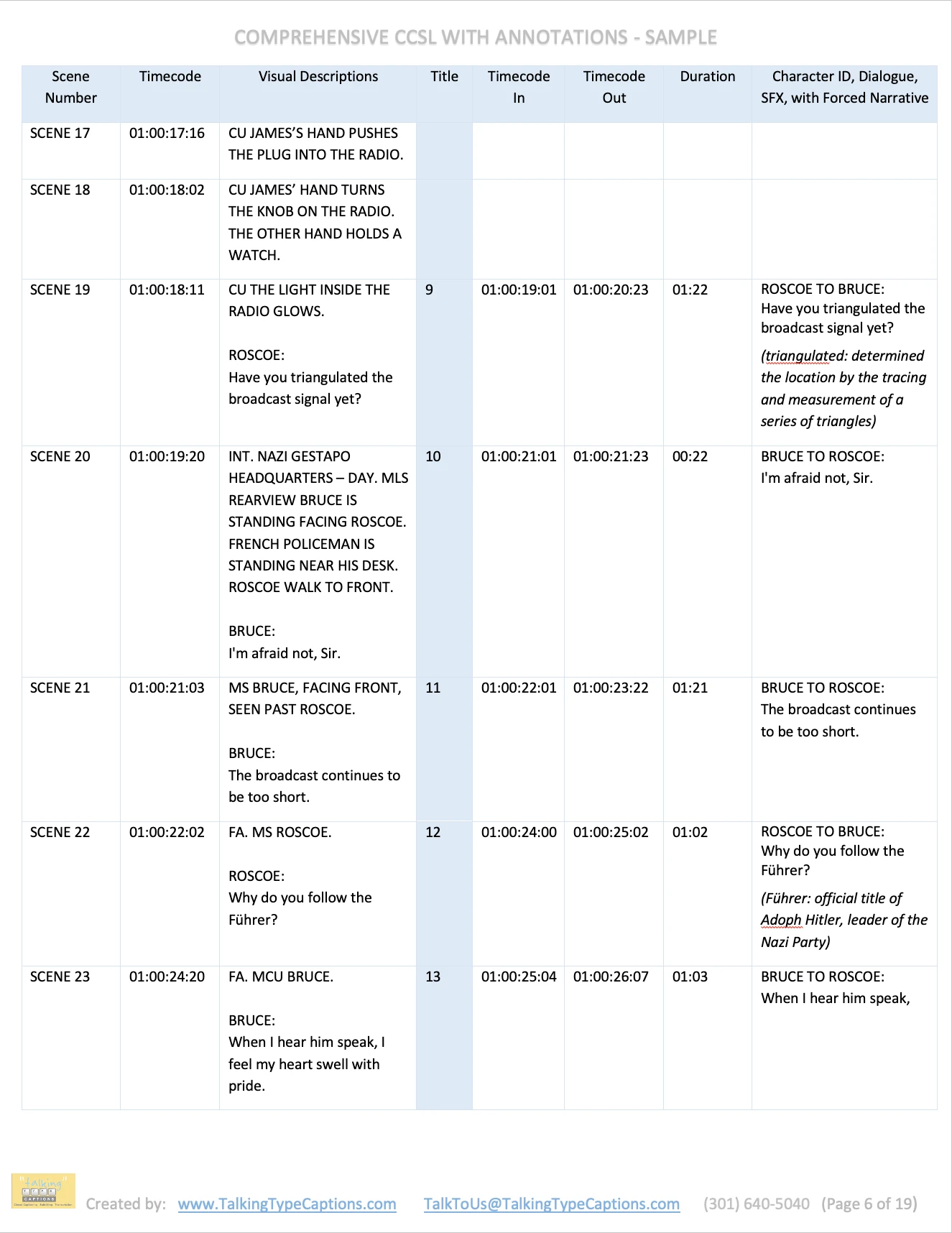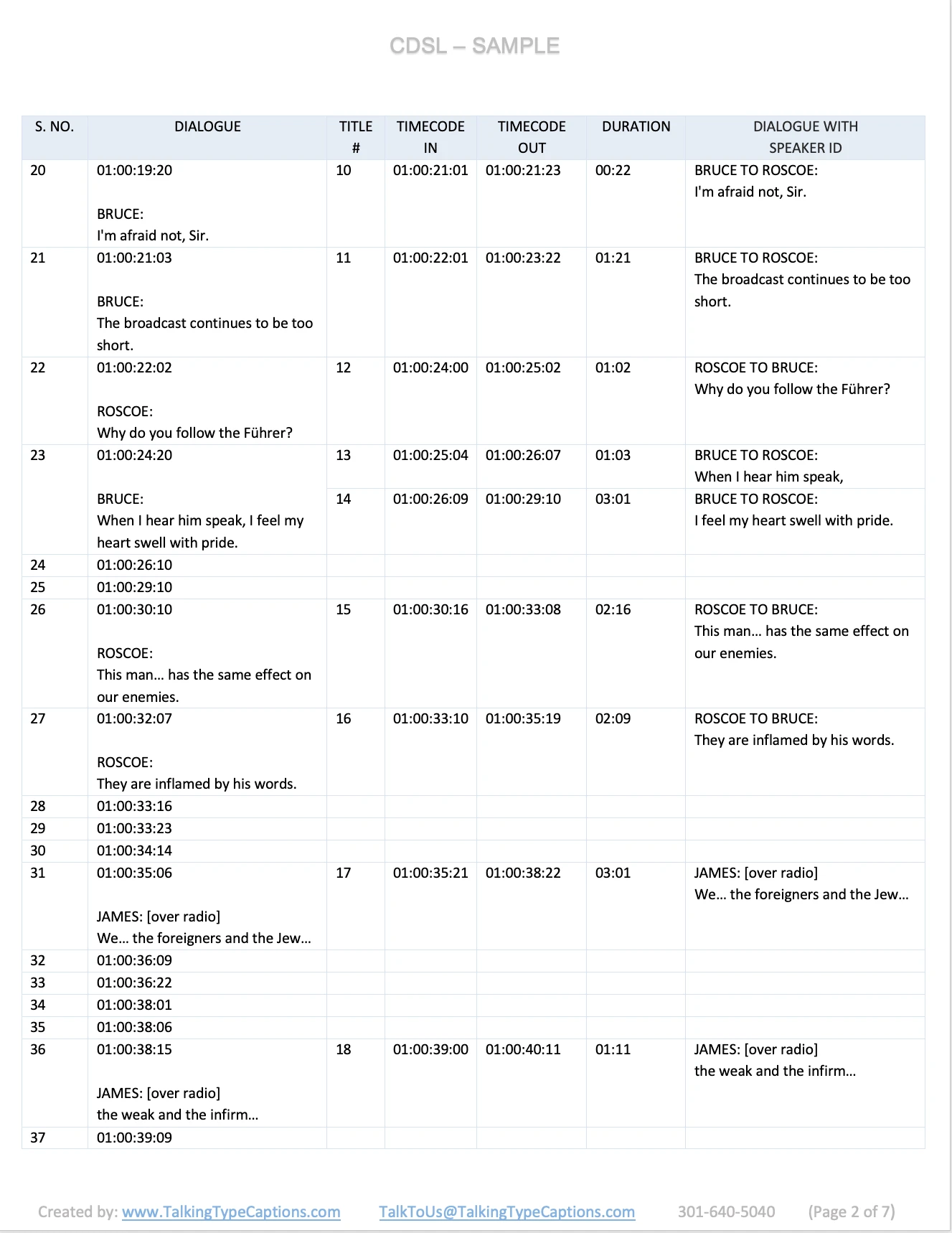CCSL - Combined Continuity
and Spotting List

What is a CCSL Film Script?
A Combined Continuity and Spotting List, also called CCSL in short, is a post production script of the final broadcast of a movie or television show in a written text form.
It’s a shot by shot description of the visual and audible content of the media. Complete with the frame-precise time codes, visual description of the action on the screen, lower-thirds, graphics, forced narratives and dialogue, a Combined Continuity and Spotting List is a faithful rendition of the deliverable master video.
The Talking Type Advantage
At Talking Type, we’ve been creating CCSL Scripts for more than 19 years. Having gathered all this experience with virtually every network and film production companies and distributors, our post production lists are in a class all by themselves. And are also very reasonably prices.
That’s the advantage of working with Talking Type – quick, accurate and affordable CCSL, As Broadcast Script and Dialogue Lists. Check out all our samples and prices.
Download a List of Abbreviations (names of shots) that are used to describe visual in a CCSL Transcription continuity list.
CCSL Samples
The following are the most popular CCSL transcription types that we have worked with over the past 16 years. The comprehensive CCSL script that you will see below is the most prevalent.
Continuity List
A Spotting List refers to the dialogue when it is broken down into individual subtitles. Each subtitle is called a spot. It also includes all forced narrative that are a part of a subtitled show such as any foreign language spoken, any text that is visible on the screen, any signs, title of books, etc.
What Goes Inside a CCSL?
SHOT FRAMING
-
ECU:
Extreme close up reveals subject in extreme detail. -
CU:
Close up reveals subject in detail, takes up most if not the entire screen. -
MCU:
Medium close up takes up about 3/4 of the screen.
-
MS:
Medium shot shows subject as well as part of its surroundings. This is the broadest shot type, encompassing shots from a variety of distances.
-
WS:
Wide shot is taken from a relatively long distance; main subject appears small in respect to the entire frame.
-
EWS:
Extreme wide shot is taken from a relatively long distance; main subject appears small in respect to the entire frame and is basically reduced to a small dot on the screen.
CAMERA MOVEMENT
-
AER:
Aerial view, may be LOW (as in close to the ground) or HIGH (above or right below the clouds). -
CRANE:
Shot from above the subject, the mounting that supports the camera rises. -
DOLLY IN:
Entire camera moves toward the subject, generally slower than a zoom. -
DOLLY OUT:
Entire camera moves away from the subject, generally slower than a zoom. -
PAN LEFT:
Camera rotates to the left. -
PAN RIGHT:
Camera rotates to the right. -
POV:
Point of view reflects the view as seen from a specific station (e.g. prow of a boat) or by a specific view (e.g. dog) in a specific location. The point of view makes you feel as if you were moving through the shot yourself. For example, POV dog's eye view or POV from prow of boat. -
Rack Focus:
Objects in the F/G and B/G move alternatively in and out of focus. -
Shaky Camera:
Camera is excessively unsteady, image shakes. -
Tilt Down:
Camera tilts down.
-
Shaky Camera:
Camera is excessively unsteady, image shakes. -
Tilt Down:
Camera tilts down. -
Tilt Up:
Camera tilts up. -
TRK:
Tracking shot is a moving shot in which the camera is perpendicular and runs parallel to the subject. -
TS:
Traveling shot is taken from a moving location (plane, boat, car, etc.).
-
UW:
Underwater shots of the subject are taken underwater or appear as if they were (e.g. shots of fish through aquarium glass).
-
ZOOM IN:
Camera's focal length from the subject is shortened, the camera remains stationary.
-
ZOOM OUT:
Camera's focal length from the subject is lengthened, the camera remains stationary.
SPEED
-
REAL TIME:
The action on the screen is the same speed as the action when photographed. You would only note this is it was significant to the material. For example, REAL TIME sun sets behind snow-capped mountain.
-
SLO MO:
Slow motion, the action on the screen is slower than the action when photographed.
-
STOP ACTION:
An animation method whereby apparent motion of objects is obtained on the film by exposing single frames and moving the object to simulate continuous motion.
-
TIME LAPSE:
One frame of the film is exposed at regularly delayed intervals. Motion too slow to be detected by the naked eye can thus be sped up on the screen (e.g. plants growing).
ANGLE
-
FA:
Front angle is taken from directly in front of the subject, head-on view.
-
HA:
High angle shot is taken from angle above the subject (not necessarily from directly above).
-
LA:
Low angle shot is taken from low angle, relative to the subject (as if you were looking up at the subject).
-
RA:
Rear angle reveals the rear view of a subject.
-
SA:
Side angle views the profile of the subject.
LIGHT
-
Backlit:
Light source is behind the subject.
-
CHROMA KEY:
Image shot on specific color background, usually blue or green, that can be electronically cut out and inserted over a new background.
-
CAMERA FLASH:
First of last frame or frames of a shot that are overexposed due to time lag in the camera motor reaching the correct speed.
-
HEAT SHIMMER:
Causes a wavering sometimes distorted visual image. Usually results from head included changes in atmospheric refraction.
-
Lens Flare:
Light resulting from reflection between lens surface or the effect of this light.
-
Overexposed:
Too much light on the film, making the subjects look washed out, non-distinguishable. Only take shots with this problem if the subject matter is more significant than the technical quality.
-
Silhouette:
Subject appears in silhouette.
-
Underexposed:
Too little light on the film, making the subjects look very dark and very indistinct.
OTHER TERMS USED TO ADD FURTHER CLIP DETAIL
-
Approaches Camera:
Approaches camera is used when the subject of the shot is clearly approaching the camera. -
B/G:
Background is used to identify something in the background of a shot. -
DISSOLVE:
One shot blends into the next. -
EST:
Establishing shot sets up the scene, establishes it. They are signature shots, "postcard" views. -
F/G:
Foreground is used to identify something in the foreground of a shot. -
JUMP CUT:
A cut between two edited shots that seems abrupt and calls attention to itself because some of obvious jump in time or space. At times the cut is consciously made during editing for some desired effect. -
Scruffy:
Animals that looks roughed up, not to be used for shedding animals. -
Landscape:
A good overall view of a landscape, natural setting. -
Locked down:
Looks like a still (no action or movement).
-
Out of focus:
Blurry Shot -
Portrait:
Typifies a certain concept, nationality, ethnicity or political view. -
Reenactment:
Dramatization of the actions associated with an earlier event or incident. -
Scenic:
A picturesque view or landscape. -
Soft Focus:
The subject has no harshly defined lines and is slightly out of focus (for effect) -
SFX:
Used to indicate a special effect. Special effects include... star filters, prismatic cameras, and under cranked work (action on the screen is faster than the action when photographed... not the same as time lapse... similar to old time picture shows.) For example, SFX MS star filter used on sun. -
Various:
Placed in front of specific shot types to signify a grouping of shots of similar subject matter of the stated type. For example, VARIOUS MCU CU bear walks in forest. VARIOUS LS leopard stalks impala.
SIGNIFICANT TERMS USED IN THE DESCRIPTION FIELD
-
Conversing:
For animals that look like they are talking -
Circa_19:
For a shot that looks particularly dated (e.g. from the 60's, 70's or 80's) -
Great for Advertising:
A shot perfect for advertising. -
Mountain Range:
To describe a range of mountains. -
Only:
As in "sky only" or "water only" -
Reacts / Reacting:
Used for people or animals that are reacting to the camera. -
Scruffy:
Animals that looks roughed up, not to be used for shedding animals. -
Single:
To signify a shot showing only a single animal. Use instead of "one" or "lone".
-
Sleepy:
To describe an animal or person which looks particularly sleepy. -
Snow-capped Mountain:
Use to describe a classic snowy mountain. -
Startled:
An animal or person which looks surprised. -
Sudden Predation:
Use to describe an unexpected attack on prey by a predator. -
Sun Dappled:
Use to describe sunlight reflection off the water. -
Sunrise and Sunset:
Use only when the sun's disk is visible, otherwise use Twilight. -
Twilight:
The light between full night and sunrise or between sunset and full night produced by diffusion of sunlight thought the atmosphere and its dust. -
Unusual Looking Behavior:
Animals behaving in a way that may be perfectly natural to them, but that may look strange to us.
SIGNIFICANT TERMS USED IN THE DESCRIPTION FIELD
- Use the appropriate terms of young animals (e.g. pup, chick, duckling)
- Animals of different genders sometimes look differently. Identify the sex of the animal when possible.
- If the male and female have different names, "lion" or "lioness" for example, use those names.
What is a CCSL transcription used for?
-
Legal use
The CCSL serves as a paper form of the video content. When a production is distributed internationally, the CCSL serves as a guide that provides compliance (censorship) officers the information they need to conform the production to the legal standards of their region. It’s a necessary part of deliverables to networks or a studios and is an invaluable tool with reediting the content if needed for different market sensibilities. -
Subtitling and Dubbing
Most helpful with subtitling and dubbing a video into foreign languages. Especially with annotated dialogues. Once the in-timecode and the out-timecode of a dialog have been captured on paper, the duration calculated, the voice-over for the dubber has a precise idea of the time that is available to fit in the dialog in the foreign language.
CCSL Transcription Workflow
- 1. Transcribing the dialogue.
- 2. Creating a closed captioning file to get the in time and out time and duration of the dialog. With proper tools it is much easier to capture the time codes than type them by hand. One of the advantages is that our software automatically calculates the duration of the dialog.
- 3.. Exporting the dialog, time in, time out and duration to an Excel document.
- 4. Now the fun begins. We add the IDs of the speakers to the dialog and note down who is talking to whom, with the nuances of the dialog (whispers, stammers etc).
- 5. Along with the dialog description, we add the visual data.
What's the Difference between CDSL and CCSL continuity scripts?
A CCSL — Combined Continuity and Spotting List — contains visual descriptions (continuity) which is a shot by shot description detailing the action on the screen from the beginning of a shot to the end of the shot. It notes the camera angels, the action on the screen, any graphics or chyrons, lower-thirds, any signs or words on any article in the shot. It is a visual in word form. Each shot has its time code in and time code out noted along with the total duration of each shot.
A CDSL —
Combined Dialogue and Spotting List , is a spotting list that is combined with a complete dialogue list. It does not contain continuity (visual descriptions) but instead the complete dialogue is noted in its entirety. In addition the dialogue is also presented in the form of subtitles (spotting list).
Seamless Production with CCSL Service!
Enhance your film or TV production with Talking Type Captions! Our Combined Continuity and Spotting List (CCSL) service ensures a detailed reflection of every shot, dialogue, and sound element. Partner with us for a seamless production journey.
Unlocking Precision in Film
Have you ever wondered how to meticulously capture every frame, dialogue, and atmospheric element in your film or TV production? Talking Type Captions has the answer.
With our combined continuity and spotting lists (CCSL) expertise, we transform your narrative into a structured masterpiece. We have two decades of experience working within the film and television production industry, across the United States, the United Kingdom, and elsewhere.
Our extensive experience and industry leadership make us your trusted collaborator. Experience the difference precision can make in your production. Connect with Talking Type Captions and discover how we bring precision to every frame.
What is CCSL?
In the world of filmmaking, a combined continuity and spotting list (CCSL) is like the behind-the-scenes storyteller, meticulously capturing every detail that unfolds on the screen.
Think of it as a comprehensive diary of your production, jotting down not just the dialogue but also the actions of the characters, the flow of the camera, scene descriptions, and the ambiance. It includes every bit that contributes to the magic of your story.
Unlike a regular script, a CCSL dives deep, dissecting each moment to give you a snapshot of the entire visual and auditory journey. It’s your go-to guide, ensuring no nuance is left unnoticed.
With CCSL, every scene is carefully documented, becoming a vital piece in the puzzle that forms your complete, captivating narrative. Ready to unravel the secrets of your production? The CCSL is your key.
What Are the Benefits of CCSL?
Understanding Every Shot
CCSL acts as your media company’s precision toolkit, offering an in-depth understanding of every shot. It ensures that no visual or auditory detail goes unnoticed.From character expressions to camera movements, CCSL provides a meticulous breakdown that becomes the foundation for crafting compelling narratives.
Adaptation Across Platforms
With the global reach of media, seamless adaptation is crucial. CCSL facilitates effortless transitions across languages, platforms, and cultural contexts.
Whether it’s subtitling, dubbing, or accessibility features, the detailed breakdown allows for your content to resonate authentically with diverse audiences.
Elevating Dialogue and Scene Dynamics
Dialogue and scene dynamics are the heartbeat of any production. CCSL, with its focus on precision, becomes your company’s guide to elevating the impact of dialogue delivery and scene composition. It ensures that the rhythm and emotion of each line are faithfully preserved, adding depth to your storytelling.
Collaboration Across Teams
CCSL also serves as a collaborative bridge. It helps to facilitate enhanced communication across production teams. From scriptwriters to editors, the detailed breakdown fosters a shared understanding of the creative vision.
Time and Cost Efficiency
Efficiency is paramount in media production. CCSL streamlines the workflow, saving both time and cost. Providing a detailed roadmap of every scene minimizes the need for extensive revisions and reshoots, meaning that your projects stay on schedule and within budget.
Preservation of Creative Intent
CCSL acts as the guardian of your creative intent. Capturing not just the spoken words but the nuances, atmosphere, and emotions within each scene ensures that your original vision remains intact.
Strengthening Your Reputation
Incorporating CCSL into your production workflow signifies a commitment to precision and excellence. This dedication enhances your company’s reputation within the industry.
Improved Accessibility and Inclusivity
In an era of heightened awareness about accessibility, CCSL plays a pivotal role in making your content more inclusive. The detailed transcriptions make your productions accessible to audiences with varying needs, contributing to a more inclusive and diverse media landscape.
Confidence in Distribution
When your production is ready for distribution, CCSL becomes your confidence booster. Its detailed breakdown ensures that your content aligns seamlessly with distribution requirements, whether it’s for traditional broadcast, streaming services, or international markets.
CCSL for Film: How It Works
1. Submission and Consultation
Your journey with Talking Type Captions begins with a straightforward process. Submit your script or raw footage, and let the collaboration unfold.
This initial step is a consultation where your vision and requirements take center stage. We delve into the intricacies of your production. This is something that ensures a clear understanding of your storytelling nuances and unique elements.
2. Transcription and Precision Crafting
Once we’ve gathered your materials, our expert team takes the reins. The magic begins with meticulous transcription. We transform spoken words into a detailed CCSL, capturing not just the dialogue but the essence of each shot.
This step is a symphony of precision crafting, where every line, every action, and every atmospheric element is carefully cataloged. Our goal is to breathe life into your narrative on paper. This helps to preserve the creative nuances that make your production unique.
3. Client Feedback and Refinement
Here at Talking Type Captions, we believe in collaboration and refinement. The third step involves an iterative process, where your feedback becomes our guiding compass. We present the initial CCSL draft, and your insights play a crucial role in shaping the final product.
This refinement ensures that the CCSL aligns seamlessly with your creative vision. Each round of feedback brings us closer to perfection, making the process not just efficient but tailored to your specific needs.
Why Partner With Talking Type?
Years of Industry Expertise
Talking Type Captions brings 20 years of invaluable industry expertise to the table. Our journey, rooted in the evolution of media technologies, reflects a commitment to excellence that has stood the test of time.
With a wealth of experience, we navigate the complexities of media production with confidence, offering a level of insight and understanding that sets us apart.
Attention to Detail
Precision is our forte. At Talking Type Captions, attention to detail is not just a part of our process; it’s also a core value. Every frame, every line of dialogue, and every ambient sound is cataloged with meticulous care. This level of detail guarantees a CCSL that not only meets but exceeds your expectations, elevating the quality of your production.
Customized Solution
We understand that every project is unique, and your creative vision is distinct. Talking Type Captions tailors its services to fit your specific needs.
Whether it’s adapting to your storytelling style, accommodating unique production elements, or addressing specific distribution requirements, our team crafts customized solutions that amplify your creative intent.
Commitment to Refinement
Our team embraces an iterative refinement process driven by client feedback. Your insights become the driving force behind personalized adjustments, ensuring that the CCSL aligns seamlessly with your vision.
This commitment to refinement guarantees a final product that not only meets but exceeds your expectations.
Global Recognition and Trust
We have built our reputation over the course of 20 years by providing the highest quality services to our clients. Our global recognition is a testament to the reliability, precision, and professionalism we bring to every CCSL project.
A Long-term Partner
Choosing Talking Type Captions means having a partner for the entire production journey. From the initial script to the final distribution, our involvement ensures continuity, coherence, and a unified approach.
About Us
Since our inception in 2003, Talking Type Captions has stood as a trailblazer in closed captioning, subtitling, and script services for the film and television industry.
What began in a humble garage has flourished into two dedicated offices, with our headquarters in Bethesda, MD. As we expand our company, we pledge to serve every client, old and new, ensuring that our expertise enriches every frame of your storytelling canvas.
Click below to learn about our history and our vision for the future.
Read Our Reviews
Interested in learning more about what our clients have to say about us? If so, keep reading to see why we are a leading provider of CCSL services.
Elevate Your Production with Talking Type
Ready to transform your film or TV production? Partner with Talking Type Captions for a CCSL experience like no other. Contact us today, and let’s bring your visual and auditory narrative to life with precision and expertise.


Need CCSL Services?
Top-notch quality at affordable rates, it doesn’t
get better than Talking Type!




